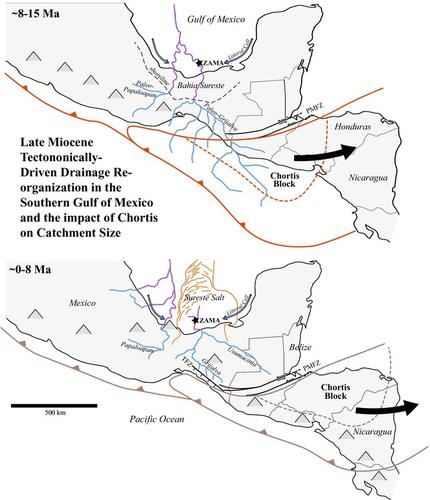当前位置:
X-MOL 学术
›
Basin Res.
›
论文详情
Our official English website, www.x-mol.net, welcomes your
feedback! (Note: you will need to create a separate account there.)
Reconstructing the Zama (Mexico) discovery source to sink story, Part I; detrital zircon U–Pb and (U‐Th)/He provenance analysis and implications for sediment source terranes
Basin Research ( IF 2.8 ) Pub Date : 2024-09-19 , DOI: 10.1111/bre.12899 D. F. Stockli, J. W. Snedden, T. F. Lawton, M. Albertson, J. Pasley
Basin Research ( IF 2.8 ) Pub Date : 2024-09-19 , DOI: 10.1111/bre.12899 D. F. Stockli, J. W. Snedden, T. F. Lawton, M. Albertson, J. Pasley

|
The Zama discovery was identified off the coast of Tabasco, Mexico, in the Sureste Basin of the Gulf of Mexico and is hosted in a three‐way closure in the Upper Miocene. This study conducted a detailed detrital zircon (DZ) U–Pb and (U‐Th)/He provenance analyses on samples from sandstone reservoirs in the Zama‐3 and Zama‐2ST1 wells. A total of 22 sandstone samples (11 from each well) were collected for DZ U–Pb and (U‐Th)/He dating from different reservoir zones, testing the hypothesis that different zones were whether originally derived from varied sedimentary source terranes and associated transport pathways to the Zama mini‐basin depositional site. Additional objectives include determination of maximum depositional ages, reconstruction of paleofluvial systems, and exploring the temporal evolution of the drainage region and hinterland tectonics. The DZ U–Pb age spectra from both Zama wells have remarkably homogenous DZ signatures with very similar DZ age modes and modal percentages, displaying dominant Permian/Chiapas Batholith (ca. 35%–45%), Mesoproterozoic/Oaxaquian (ca. 20%–35%), Early Palaeozoic/Acatlán (ca. 8%–20%), and Cenozoic magmatic arc (ca. 15%–25%) age modes, as well as some subsidiary (<5%) early Proterozoic/Archean and Early Cretaceous DZ age components, linked to recycled lower Palaeozoic strata and the Guerrero Terrane and Alisitos arc, respectively. Despite differences in paleocurrent directions, deduced from image logs, there are no systematic differences in DZ spectra, indicating a consistent sediment provenance and no changes in source area. All Zama samples analysed in the study are characterized by abundant syn‐depositional Late Miocene DZ grains, clustering between 8.6 and 10.2 Ma, corroborating a Tortonian (Late Miocene) depositional age, and yield rapid sediment accumulation rates of ca. 200 m in <1.4 Ma (13 m/Myr). Doubled zircon U–Pb and (U‐Th)/He age pairs are indicative of recycling of early Mesozoic rift strata and Paleogene and younger Chiapas basement. These new DZ U–Pb and (U‐Th)/He data have a nearly invariant Tortonian sediment provenance that is similar to the modern Grijalva River flowing generally northward out of the Chiapas highlands. The paleo‐Grijalva drainage, providing sediment to the Late Miocene Zama mini‐basin, was likely drastically larger than the present catchment as it involved 10 Ma plutonic sources that were subsequently downfaulted along the Pacific coast in the latest Miocene. Importantly, DZ U–Pb age components are consistent with Oaxaquia, early Acatlán, and Guerrero/Alisitos signatures and point to sourcing from the Chortis block during its tectonic eastward translation. Such a scenario would allow for a substantially larger Miocene paleo‐drainage that would have encompassed both Chiapas and portions of Chortis. The Miocene tectonic translation of Chortis and erosion of a large and tectonically active hinterland would also reconcile the dramatically larger Middle to Late Miocene sediment supply, funnelling a large influx of sediment into the southern Gulf of Mexico. Rapid Late Miocene sediment accumulation in the salt‐defined Zama mini‐basin must have involved sustained sediment flux via the paleo‐Grijalva drainage and was likely facilitated and focused by continued salt deflation due to sediment loading, as described in Part II. Thus, our work provides new scientific insights into one of the largest hydrocarbon discoveries in Mexico in recent years.
中文翻译:

重建扎马(墨西哥)发现源头沉没的故事,第一部分;碎屑锆石 U-Pb 和 (U-Th)/He 物源分析及其对沉积物源地体的影响
Zama 发现地位于墨西哥塔巴斯科州海岸附近的墨西哥湾 Sureste 盆地,位于上中新世的三向封闭区域。本研究对 Zama-3 和 Zama-2ST1 井砂岩储层的样品进行了详细的碎屑锆石 (DZ) U-Pb 和 (U-Th)/He 物源分析。共收集了 22 个砂岩样品(每口井 11 个),对不同储集层的 DZ U-Pb 和 (U-Th)/He 进行测年,检验了不同储集层是否最初源自不同沉积源地体以及相关联的假设。通往扎马小型盆地沉积地点的运输路径。其他目标包括确定最大沉积年龄、重建古河流系统以及探索流域区域和腹地构造的时间演化。扎马两口井的 DZ U-Pb 年龄谱具有非常均匀的 DZ 特征,具有非常相似的 DZ 年龄模式和模式百分比,显示出主要的二叠纪/恰帕斯岩基(约 35%–45%)、中元古代/瓦哈奎纪(约 20%) –35%)、早古生代/Acatlán (约 8%–20%) 和新生代岩浆弧 (约 15%–25%) 年龄模式,以及一些附属 (<5%) 早元古代/太古宙和早白垩世 DZ 年龄成分,分别与再生的下古生代地层以及格雷罗地体和阿利西托斯弧有关。尽管从图像测井推断出古水流方向存在差异,但 DZ 光谱没有系统差异,表明沉积物来源一致,源区没有变化。研究中分析的所有扎马样品都具有丰富的同沉积晚中新世 DZ 颗粒的特征,聚集在 8.6 到 10 之间。2 Ma,证实了托尔托阶(晚中新世)沉积年龄,并产生了约 2 Ma 的快速沉积物积累速率。 200 m,<1.4 Ma (13 m/Myr)。双锆石 U-Pb 和 (U-Th)/He 年龄对表明早期中生代裂谷地层以及古近纪和更年轻的恰帕斯基底的再循环。这些新的 DZ U-Pb 和 (U-Th)/He 数据具有几乎不变的托尔顿沉积物来源,类似于现代格里哈尔瓦河一般从恰帕斯高地向北流动。古格里哈尔瓦排水系统为晚中新世扎马小型盆地提供沉积物,可能比现在的流域大得多,因为它涉及 10 Ma 深成岩源,这些岩源随后在中新世晚期沿太平洋海岸断层。重要的是,DZ U-Pb 年龄成分与瓦哈萨基亚、早期阿卡特兰和格雷罗/阿利西托斯特征一致,并表明在其构造向东平移过程中源自 Chortis 地块。这种情况将允许出现更大的中新世古排水系统,该排水系统将涵盖恰帕斯州和乔蒂斯的部分地区。乔蒂斯的中新世构造平移和大片构造活跃的腹地的侵蚀也将调和中新世晚期沉积物供应的显着增加,将大量沉积物流入墨西哥湾南部。如第二部分所述,盐定义的扎马小盆地中中新世晚期沉积物的快速积累必定涉及通过古格里哈尔瓦排水系统的持续沉积物通量,并且可能是由于沉积物负载导致的持续盐紧缩而促进和集中的。因此,我们的工作为墨西哥近年来最大的碳氢化合物发现之一提供了新的科学见解。
更新日期:2024-09-19
中文翻译:

重建扎马(墨西哥)发现源头沉没的故事,第一部分;碎屑锆石 U-Pb 和 (U-Th)/He 物源分析及其对沉积物源地体的影响
Zama 发现地位于墨西哥塔巴斯科州海岸附近的墨西哥湾 Sureste 盆地,位于上中新世的三向封闭区域。本研究对 Zama-3 和 Zama-2ST1 井砂岩储层的样品进行了详细的碎屑锆石 (DZ) U-Pb 和 (U-Th)/He 物源分析。共收集了 22 个砂岩样品(每口井 11 个),对不同储集层的 DZ U-Pb 和 (U-Th)/He 进行测年,检验了不同储集层是否最初源自不同沉积源地体以及相关联的假设。通往扎马小型盆地沉积地点的运输路径。其他目标包括确定最大沉积年龄、重建古河流系统以及探索流域区域和腹地构造的时间演化。扎马两口井的 DZ U-Pb 年龄谱具有非常均匀的 DZ 特征,具有非常相似的 DZ 年龄模式和模式百分比,显示出主要的二叠纪/恰帕斯岩基(约 35%–45%)、中元古代/瓦哈奎纪(约 20%) –35%)、早古生代/Acatlán (约 8%–20%) 和新生代岩浆弧 (约 15%–25%) 年龄模式,以及一些附属 (<5%) 早元古代/太古宙和早白垩世 DZ 年龄成分,分别与再生的下古生代地层以及格雷罗地体和阿利西托斯弧有关。尽管从图像测井推断出古水流方向存在差异,但 DZ 光谱没有系统差异,表明沉积物来源一致,源区没有变化。研究中分析的所有扎马样品都具有丰富的同沉积晚中新世 DZ 颗粒的特征,聚集在 8.6 到 10 之间。2 Ma,证实了托尔托阶(晚中新世)沉积年龄,并产生了约 2 Ma 的快速沉积物积累速率。 200 m,<1.4 Ma (13 m/Myr)。双锆石 U-Pb 和 (U-Th)/He 年龄对表明早期中生代裂谷地层以及古近纪和更年轻的恰帕斯基底的再循环。这些新的 DZ U-Pb 和 (U-Th)/He 数据具有几乎不变的托尔顿沉积物来源,类似于现代格里哈尔瓦河一般从恰帕斯高地向北流动。古格里哈尔瓦排水系统为晚中新世扎马小型盆地提供沉积物,可能比现在的流域大得多,因为它涉及 10 Ma 深成岩源,这些岩源随后在中新世晚期沿太平洋海岸断层。重要的是,DZ U-Pb 年龄成分与瓦哈萨基亚、早期阿卡特兰和格雷罗/阿利西托斯特征一致,并表明在其构造向东平移过程中源自 Chortis 地块。这种情况将允许出现更大的中新世古排水系统,该排水系统将涵盖恰帕斯州和乔蒂斯的部分地区。乔蒂斯的中新世构造平移和大片构造活跃的腹地的侵蚀也将调和中新世晚期沉积物供应的显着增加,将大量沉积物流入墨西哥湾南部。如第二部分所述,盐定义的扎马小盆地中中新世晚期沉积物的快速积累必定涉及通过古格里哈尔瓦排水系统的持续沉积物通量,并且可能是由于沉积物负载导致的持续盐紧缩而促进和集中的。因此,我们的工作为墨西哥近年来最大的碳氢化合物发现之一提供了新的科学见解。

































 京公网安备 11010802027423号
京公网安备 11010802027423号